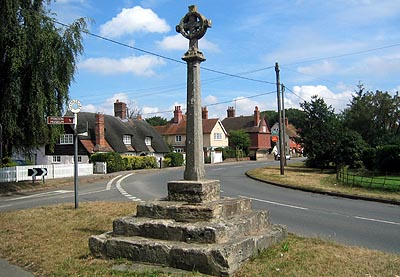 |
 |
|||
|
|
The first ever use of crop-marks to detect archaeological remains took place at North Field Farm, down by the Thames. In the 1890s, it was noticed that crops grew taller above ditches and shorter above walls hidden below the ground. Numerous enclosures and hut-circles were identified and mapped out with incredible accuracy. The latter are probably of Bronze Age date, but limited excavation has shown the other remains to be a Romano-British farmstead. Perhaps this was the original Wittenham. The name could be from Vedonium, Brito-Latin for 'Wet Town', referring to the flooding river rather than inclement weather. St. Anthony's Well, at the west end of the village, is traditionally said to have magically healing powers. It was probably derives its dedication from the Celtic Mother Goddess, Anu. A Saxon cemetery, discovered in Free Acre in 1859, has revealed over a hundred and eighty-eight burials: men, women and children, spanning across several centuries. Roman coins and vessels show some to be among the earliest Germanic inhabitants in the country, settling here even before the Romans left our shores, perhaps as mercenaries. Evidence of similar settlers has been forthcoming from nearby Dorchester (Oxon) and Abingdon. They were probably German mercenaries and their families. Numerous Saxon objects were recovered from the Wittenham burial ground, including many fine brooches. Most of the men had spears and round shields. Two with swords may have been thegns. However, as the cemetery enlarged, artifacts disappear and the burials become east-west in orientation. This indicates these people had been converted to Christianity. One young boy's grave did include some personal possessions: a small knife, a spear, a bronze cauldron and a beautiful decorated stoup for holy water, featuring Christ's Chi-Rho symbol, the Annunciation, his Baptism and the Wedding at Cana! It is usually thought to be of Frankish origin and has been closely dated to AD 500. Suggestions that it was actually made in Britain are, so far, unconvincing. However, the West Saxons were not converted to Christianity until St. Birinus arrived in AD 634. Indeed, the base of the village cross is said to be from where he preached to the locals. Were the Wittenham people Frankish Christians or converts of the local British perhaps? The area was certainly an important Anglo-Saxon centre and a high-status settlement with great feasting halls and associated domestic and farm buildings has been identified by aerial photography. It may have been the home of the leader of the Gewissae who ruled Wessex in the 6th century and whose descendants later moved to Sutton Courtenay; or perhaps it was just the 7th or 8th century home of the original Witta whose 'hamm' or water meadow is usually said to have given the village its name. The south transept of the parish church is thought to have been built by Princess Joan of Acre, daughter of King Edward I, as a memorial chapel to her husband, Gilbert 'the Red' De Clare, Earl of Gloucester and Lord of Wittenham. He has the smallest effigial monument in the country as the base of the chapel's piscina! There is also, however, a tomb recess, possibly for a memorial brass. Gilbert was one of the leading Barons in their struggle against Henry III. His major lands were in the Welsh Marches, but he must have often stayed at Wittenham when attended the King at Oxford and Woodstock. The village was called Earl's Wittenham in his honour. Red Gilbert died in Monmouth in 1295 and was buried in Tewkesbury Abbey, so why Joan should wish him to have a memorial here is something of a mystery. It has been suggested that small effigies signify the burial of a deceased person's heart. So, presumably, Joan retired to Wittenham and wished at least part of her beloved husband to be near her. The church's other great treasures are the screen and choir stalls from Exeter College, Oxford and the fine 12th century lead font, embossed with the figures of thirty Archbishops. During the Civil War, Oliver Cromwell himself is said to have visited the village (his cousin lived at Little Wittenham House). Worried that the font might be melted down for bullets by his Roundhead soldiers, it was encased in wood. It wasn't rediscovered until the 1830s. Just west of the church, the remains of the village cockpit can be found. Behind the building is a fine brick and timber dovecote. A devastating fire, in 1868, destroyed many ancient buildings in the village, though several still survive. The beautifully thatched Barley Mow pub is where Jerome K. Jerome wrote his classic, 'Three Men in a Boat'.
|
|||
| © Nash Ford Publishing 2004. All Rights Reserved. This location is now administered by Oxfordshire County Council. | ||||



 Long
Wittenham
Long
Wittenham